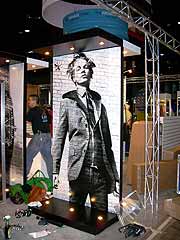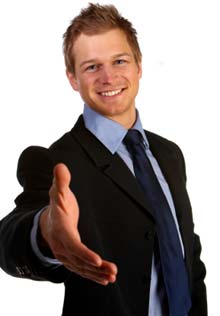What To Do With An Old Trade Show Exhibit
What is the Value Of A Used Trade Show Display?
There are many reasons why a company might decide that they no longer want or need their current trade show booth. Perhaps budgets have been slashed, requiring reduced space and a too large, too heavy and too expensive to set up exhibit will no longer meet needs. Or conversely, it could be a result of growth that requires a step up in size and/or capability. Has the exhibit become outdated? No longer fits the company’s image? If you’ve considered updating the existing booth with new graphics or supplementing with rental components, and that just isn’t an option, then what?
 Before considering your disposal options, you must first consider the fact that the tradeshow display probably appears as an asset on the company’s books. So, if disposed of, it will result in a loss on financial statements. Add to this the fact that the display consists of some hazardous materials, so disposal costs will be significant and you can see why disposal is not likely to be a popular move in the eyes of the bean counters.
Before considering your disposal options, you must first consider the fact that the tradeshow display probably appears as an asset on the company’s books. So, if disposed of, it will result in a loss on financial statements. Add to this the fact that the display consists of some hazardous materials, so disposal costs will be significant and you can see why disposal is not likely to be a popular move in the eyes of the bean counters.
Also, be realistic about the value of a used tradeshow display. Companies generally want to design a new booth to their own specifications. Even if your display closely matches their needs, the cost of refurbishment, changing finishes and colors and producing new graphics can quickly add dramatically to the cost. It is not unusual for tradeshow booths that originally cost hundreds of thousands of dollars to be nearly worthless in the used market.
Options For Your Old Trade Show Booth
So… what are your options?
- Bite the bullet. Get a quote from your display company, pay the handling and disposal fees, write off the loss, and move on. (This is a major reason many companies choose to only rent their displays).
- Try to sell your old tradeshow booth. Gather as much information about the display as possible. Photos, drawings and inventory lists are critical to success. Post the display on a used exhibit web site (www.exhibitrader.com for example). Ebay and Craigslist might work to sell portable exhibits, but larger displays probably won’t get much attention. Be realistic about an asking price.
- Make a deal with your exhibit company. Roll the old booth into the purchase or rental of a new display. Showing a “trade-in allowance” on the contract will be much easier on the financial statements and also eliminate your disposal liability.
- Donate your booth. Try to find a charity that might have some use for all or part of the display. Admittedly, this is a long shot, but is worth checking into.
No matter which direction you take, it is always a shame that something so exciting and valuable when it was originally built ends up such a pain to get rid of.
Signage at Tradeshows: How Big is Too Big?
All companies that exhibit at tradeshows want their name to be the most prominent in the convention center. At large shows with hundreds of exhibits this is obviously not possible. When you walk into the exhibit hall, you are confronted with sea of visual clutter. So what is the correct approach to signage in your booth?
Consider this:
Exhibit signage breaks down into 3 basic categories, long, medium and short range graphics. Each of these categories serves a practical purpose.
Long Range Graphics
 These are most often corporate identification graphics. In island or peninsula displays, they can be large signs that are placed at the maximum height allowed by the show. They are sometimes suspended from the convention center ceiling (where permitted) or can be supported from the floor on tall columns. The purpose of long range graphics is to allow visitors to locate your exhibit from the entrance of the hall or at least from several aisles away. Most companies want these signs to be as large as possible, so they can’t be too big. When every exhibit has these large signs, they lose their effectiveness. Sometimes adding lighting or rotating the signs will add interest. These types of signs are generally not permitted in backwall displays.
These are most often corporate identification graphics. In island or peninsula displays, they can be large signs that are placed at the maximum height allowed by the show. They are sometimes suspended from the convention center ceiling (where permitted) or can be supported from the floor on tall columns. The purpose of long range graphics is to allow visitors to locate your exhibit from the entrance of the hall or at least from several aisles away. Most companies want these signs to be as large as possible, so they can’t be too big. When every exhibit has these large signs, they lose their effectiveness. Sometimes adding lighting or rotating the signs will add interest. These types of signs are generally not permitted in backwall displays.
Medium Range Graphics
As visitors get closer to your exhibit, it is important to show them who you are and what you do. At 20 feet away from an island booth, the visitor would need to look straight up to read your large overhead sign, so medium range graphics should include your corporate identification. Individual product names and informative tag lines are appropriate at this level. In smaller displays, medium range graphics are the only corporate identification and should clearly state who you are and what you do. Medium range graphics should be large enough to be read from a reasonable distance but not too large to interfere with the exhibit design. They should be positioned at or just above eye level.
Short Range Graphics
Signs of this nature include any graphic that can only be read while standing in or very near the display. They usually include product or brand identification signs and can include more detailed information since you are conveying information to interested attendees, not trying to lure them to your display. Features, benefits, specifications and installation examples are perfect for short range graphics. These signs do not need to be very large and should be placed just below eye level for ease of view.
While these are very basic guidelines, they will result in well-designed, effective and cost effective exhibits.
Need a unique and effective tradeshow booth idea? We can help you create a custom trade show exhibit that creates a buzz about your brand and increases your booth traffic, all within your budget. Let’s Talk.
Trade Show Planning Tips – Develop a Timeline
Doing Basic Planning Makes Participation in a Trade Show More Profitable and Less Stressful.
 First ask yourself, what do you want from the show?
First ask yourself, what do you want from the show?
As you begin your planning process, be sure to understand why your company is spending the money to rent a space in the first place. Who will be attending? Which attendees are important to your company and why? What products do you have to show? What do you want to say to visitors to your booth? Gaining a clear understanding of these “strategic” goals is vital to helping everything else fall neatly into place. As such, decisions on design, graphics, product placement, staffing, etc. should all be made based on your overall show strategy.
Next, develop a timeline.
Most show manuals include a timeline or schedule of events. This is helpful for dealing with the logistical details, but you need to make a personal timeline to guide your planning. You will also need to deal with your tradeshow display, all graphics, literature and premiums, room and dinner reservations, the list goes on and on. The only way to keep all of this organized and still be able to sleep at night is to start with a timeline. The first one that you make will be very difficult and time-consuming, but with the groundwork laid, subsequent show timelines can be as easy as cut and paste.
Get some help.
Your exhibit company should be able to take most of the display issues off of your shoulders, but it is best to confirm things with them from time to time to make sure that they are on track. This will allow you to focus on the things that are more difficult to outsource.
Be sure to set internal deadlines.
Make sure that things that must be done internally are listed on your timeline and communicate deadlines well in advance to everyone involved. Often, one of the most difficult things for trade show managers to do is to get their own trade show booth shipped to the show on time. With that in mind, sometimes it makes sense to set an internal deadline that leaves you a week or so fudge factor just in case.
Brochures need to be ready to go well in advance. It may make sense to send your boxes of literature to your exhibit company so that they can ship them to the show with the display. This will allow you to check one more thing off of your list, and as an added benefit, it’s one less shipment you’ll have to track down on-site.
Develop a trade show timeline, check it several times a day, and work well in advance. It’s not as easy as it might seem, but the payoff is well worth the effort.
Need trade show advice? Let’s talk.
Trade Show Design: Audience Boredom is the Real Challenge
You’re heading to the biggest trade show of the year. You’ve checked out your competition and your exhibit looks as good as theirs looks. You have last year’s team back. Everything will be as good as it was last year. You are ready to make the most the show. But are you ready for the real competition? An audience that is totally and completely bored.
You Have Only a Brief Moment to Make an Impression at a Tradeshow! Attendees Only Recall 15% of the Displays Visited.
 People are surrounded with so much slick mass entertainment, on-demand info, interactive experiences, and noise and hype that they have moved beyond oversaturation – they are now tuning most of it out. Trade show attendees – and your target customers – are a product of this environment. They quickly scan a booth and make a very rapid decision about whether to invest more time or effort in a visit. Now, you not only have to beat your competition, you need to capture the heart and minds of your prospects that are harder than ever to engage.
People are surrounded with so much slick mass entertainment, on-demand info, interactive experiences, and noise and hype that they have moved beyond oversaturation – they are now tuning most of it out. Trade show attendees – and your target customers – are a product of this environment. They quickly scan a booth and make a very rapid decision about whether to invest more time or effort in a visit. Now, you not only have to beat your competition, you need to capture the heart and minds of your prospects that are harder than ever to engage.
Studies have found that on average trade show attendees can only recall 10% to 15% of the displays they visited 24 hours later, but the most valuable customers remember over 40% of exhibits even a year later. That is the dilemma – the casual show attendees won’t remember much but do not really matter; the high- value buyers probably remember what you did last year.
You have only one brief moment to make an impression. Do you want your target customers to see your trade show exhibit and think, “been there, done that”? (Don’t forget – your most valuable prospects never miss a show and they saw your booth last year.)
So ask this simple question: When was the last time you changed the appearance of your exhibit?
If the answer is more than two years, pick up the phone and call the best trade show exhibit designer you can find (we can help!). If your booth was typically forgettable, it will look dated. If your booth was the star of the show, it will be unforgettable and remembered as last year’s exhibit. No matter what, a dated exhibit will send the wrong message about your company and the wrong message about how you feel about the attendees of this show.
In this fast-paced, competitive world, trade show visitors want “new”. That doesn’t mean that you need a completely new exhibit, perhaps it just needs to be refreshed. But, now more than ever, it is important to show that your company understands how to succeed in this hyper-competitive marketplace.
Who Makes the Best Trade Show Booth Staff?
What to Consider When Determining the Best Staff for your Trade Show Booth
It may not always be the best idea to have your top salespeople staff your tradeshow display. There are several reasons to consider others to staff your booth.
- Most salespeople are born and bred to “close sales” and very few sales can actually be closed at a trade show.
- Salespeople will most likely have a number of current customers at the show. Tradeshow marketing objectives are, for the most part, based on gathering leads. It may be better to allow your sales staff the freedom to spend time with their customers and use others to staff your booth.
- Salespeople are typically very hard to manage. A well trained, disciplined approach to booth staffing may produce better results.
 So if not salespeople, then who does make the best booth staff? There is no one correct answer to this question. I believe that each company needs to look at the goals and objectives that they have established for each show and staff accordingly. Each tradeshow exhibit, large or small, should have a preplanned basic procedure for handling visitors that is designed to properly communicate your chosen message, answer any questions and record lead information for follow-up.
So if not salespeople, then who does make the best booth staff? There is no one correct answer to this question. I believe that each company needs to look at the goals and objectives that they have established for each show and staff accordingly. Each tradeshow exhibit, large or small, should have a preplanned basic procedure for handling visitors that is designed to properly communicate your chosen message, answer any questions and record lead information for follow-up.
There should be people assigned to greeting and qualifying visitors to the booth. This role should be filled by a person who is approachable, pleasant, smiling, energetic and a good communicator. Choose people to fill this role very carefully, as they will make that first and lasting impression on your prospects. Once a prospect has been qualified, this person should also be capable of delivering a brief presentation on your company.
As conversation with the prospect continues into more depth, there must also be someone in the booth that is very product or service knowledgeable. This could be a technical person, manager, or inside sales representative. Ideally, with the help of your staff, the prospect gets the information they need and leaves your booth with a positive impression of your company.
Think about your goals for the show and make sure to select and send the staff that gives you the best shot at not only meeting your goals, but exceeding them.
Increase Trade Show Booth Traffic with Basic Promotion Tips
Tradeshows represent a big investment. The cost of the exhibit and related services and utilities are just the beginning. Travel and lodging costs for staff will often double the total cost.
Optimize your return on investment with some supporting promotion.
 At a major show, the average trade show attendee will spend more than 2 minutes in just 26 booths. There are in excess of 1000 booths in most major shows!
At a major show, the average trade show attendee will spend more than 2 minutes in just 26 booths. There are in excess of 1000 booths in most major shows!
You should do everything possible to increase the chances that your booth will be one of these 26 for your most important prospects. Some promotion is easy, and also either cheap or free! You should touch every base for every conference where you exhibit.
- Modify your email signature
- Contact all of your prime prospects to set appointments
- Put a notice in every shipment
- Mention your booth number in your ads
- Put a banner ad on your own website
- When you invite people to your booth, tell them what’s in it for them
- Take the time to fill out the show’s exhibitor profile
- Take advantage of any publisher-offered opportunities for pre-show publicity
- Wear your logo shirt or badge at all times
- Use Social Media to create excitement about your booth
Following these basic promotion tips will attract the most important prospects! Let’s Talk.
Archives
- July 2021
- June 2021
- May 2021
- April 2021
- October 2018
- September 2018
- August 2018
- July 2018
- June 2018
- May 2018
- April 2018
- March 2018
- February 2018
- January 2018
- December 2017
- November 2017
- October 2017
- September 2017
- August 2017
- July 2017
- June 2017
- May 2017
- April 2017
- March 2017
- February 2017
- January 2017
- December 2016
- November 2016
- October 2016
- September 2016
- August 2016
- July 2016
- June 2016
- May 2016
- April 2016
- March 2016
